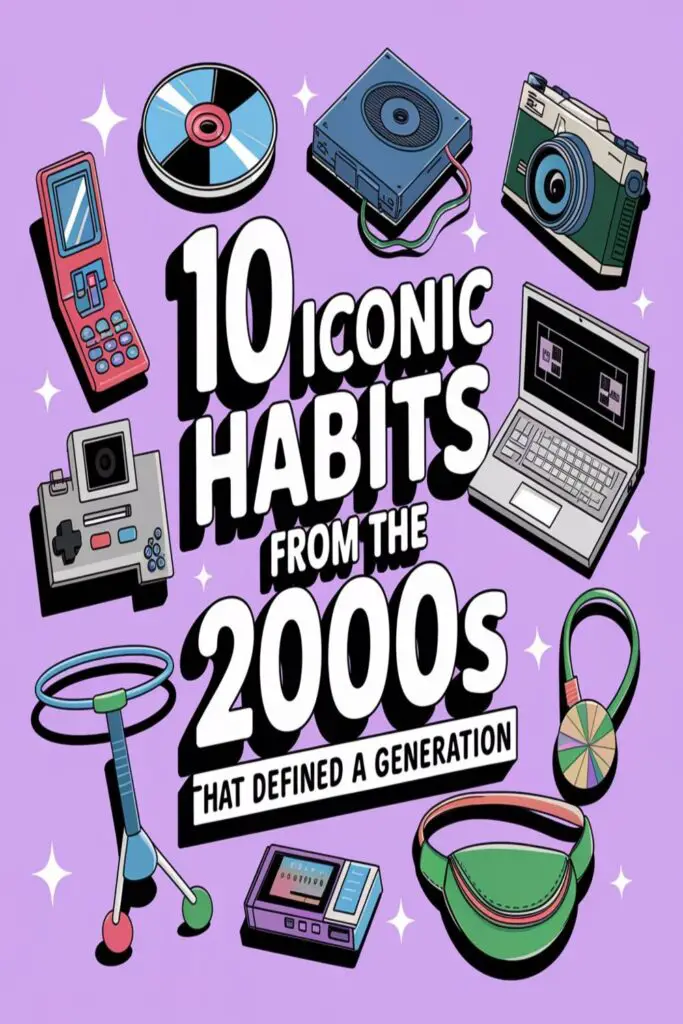The 2000s were a unique decade—filled with emerging technologies, evolving cultural trends, and shifts in how we interacted with the world. For many of us, the 2000s were the years of childhood nostalgia, and the habits we developed during that time are still part of who we are today. Whether it was flipping through magazines or sending instant messages, the 2000s shaped the way we connect, express ourselves, and consume media. Let’s dive into the top 10 iconic habits from the 2000s that defined a generation.

1. The Rise of Instant Messaging (IM)
In the 2000s, if you weren’t chatting on AIM, MSN Messenger, or Yahoo Messenger, were you even socializing? Instant messaging became the main form of online communication, allowing us to chat in real-time with friends and family across the world. It was a time before texting took over, and our screen names were our online identities.
Why it stuck: Instant messaging was the precursor to the social media interactions we use today. It taught us how to communicate quickly and casually, setting the stage for texting, social platforms, and emojis.
2. Obsession with Reality TV Shows
From The Osbournes to The Simple Life, reality TV was everywhere. The 2000s gave birth to a new form of television entertainment where ordinary people—or sometimes celebrities—were put in unusual situations for our amusement.
Why it stuck: Reality TV allowed us to peer into other people’s lives and created a new kind of celebrity, turning everyday people into household names. These shows also sparked discussions and formed connections based on shared experiences.
3. Text Messaging and the SMS Language
Texting exploded in the 2000s, especially with the rise of cell phones with full keypads. The T9 text input system revolutionized how we sent messages, and SMS language became its own cultural shorthand—using acronyms like “LOL,” “BRB,” and “TTYL” to keep conversations quick and fun.
Why it stuck: The ability to communicate quickly through short messages was groundbreaking. It made staying connected easier than ever, and many of us continue to use shorthand texting today.
4. MySpace and Early Social Media
Before Facebook and Instagram, MySpace ruled the social media scene. MySpace allowed us to customize our profiles, choose our top 8 friends, and share our favorite music with the world. It was the first platform where many of us learned how to connect online.
Why it stuck: MySpace laid the groundwork for the social media platforms we use today. It showed us how to build online identities and connect with friends, even if we were far apart.
5. The Flip Phone Obsession
Remember the iconic Motorola Razr or the Nokia 3310? The 2000s were the era of the flip phone. These phones weren’t just for calling—they were a status symbol and a fashion statement. Opening a flip phone with a snap was as cool as it got!
Why it stuck: The flip phone was the first mobile device many of us owned. It taught us the importance of portability and personal connection, and for some, it marked the beginning of the mobile age.
6. DIY Fashion and “Fast Fashion” Trends
The 2000s were filled with iconic fashion statements—from low-rise jeans to graphic tees, cargo pants, and bedazzled everything. The rise of stores like Forever 21, H&M, and Aeropostale made trendy, inexpensive clothing accessible to everyone.
Why it stuck: This fashion trend shaped how we express our personalities through clothing. The accessibility of fast fashion also made it easier to follow trends and build personal style, something many continue to do today.
7. The Addiction to Napster and LimeWire
In the early 2000s, illegal music downloads were all the rage. Napster, LimeWire, and Kazaa allowed users to download their favorite songs for free—sparking the digital music revolution. It wasn’t about streaming music; it was about building your own library.
Why it stuck: This habit gave rise to the way we consume music today. While legal music services like iTunes and Spotify replaced these peer-to-peer networks, the way we engage with music fundamentally changed during the 2000s.
8. The Emergence of Podcasts
Though podcasts weren’t as widespread as they are now, the 2000s marked the early days of podcasting as a way to share stories, news, and entertainment. Shows like This American Life gained popularity, setting the foundation for the podcast boom that followed.
Why it stuck: Podcasts introduced a new, on-the-go way of consuming content. Many people still listen to podcasts for entertainment, information, and relaxation, reflecting the 2000s habit of consuming audio content in a non-traditional format.
9. Scrapbooking and Journaling
The early 2000s saw a boom in scrapbooking and personal journaling as ways to document life, from vacations to milestones. Whether it was putting together a photo album or writing about the day’s events, scrapbooking became a beloved hobby for many.
Why it stuck: Journaling and scrapbooking allowed us to process our thoughts and preserve memories. This practice of documenting life continues today with digital photography and online journaling platforms.
10. The Social Media ‘Poking’ Phase
Facebook’s “poke” feature was once a widely-used, quirky way to interact with others. While it may seem odd now, back then, it was a fun way to get someone’s attention without sending a direct message.
Why it stuck: The concept of a non-verbal interaction was a precursor to the likes, shares, and reactions we see today on social media. The poke was one of the first ways to interact in a lighthearted, non-committal way.
Conclusion
The habits of the 2000s were shaped by emerging technologies, cultural shifts, and a desire for connection. As we move forward into new decades, these habits remind us of a simpler time—before the explosion of social media, smartphones, and streaming services. But, whether we’re still using flip phones or chatting via text, the 2000s laid the groundwork for how we interact and connect with the world today. Which of these habits do you still remember fondly?